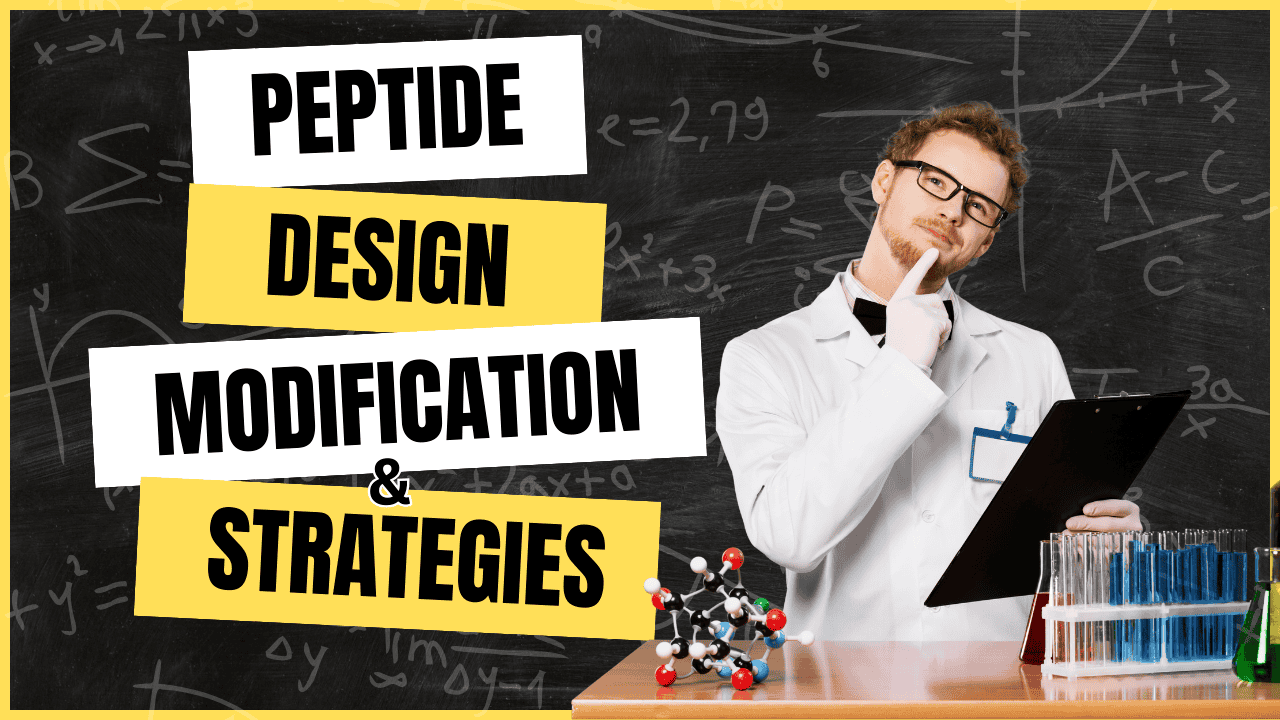

Peptides, those tiny chains of amino acids, have enormous potential in the world of therapeutic applications.
From curing diseases to personalizing medicine, peptides are the unsung heroes of drug discovery.
However, peptide stability and delivery remain critical challenges.
This article dives deep into these issues and provides a full-spectrum review.
If you’re curious about the wonders and woes of peptide therapeutics or just love a good science deep-dive, read on!
Peptide stability is influenced by several factors, ranging from environmental conditions, such as pH and temperature, to intrinsic aspects like peptide sequence and molecular weight. Imagine your peptide as a delicate snowflake; both internal and external factors can cause it to melt.
pH levels can play a significant role in peptide stability. Basic or acidic conditions can lead to peptide degradation, affecting their efficacy and shelf-life. For instance, too acidic, and your peptide might start gathering its suitcases and checking out of the molecular party.
Peptides are susceptible to various degradation mechanisms, including hydrolysis, oxidation, and enzymatic cleavage. Understanding these mechanisms is crucial to developing more stable peptides for medicinal use.
Chemical modifications, such as stapling or cyclization, are commonly employed to enhance peptide stability. These modifications can shield the peptide from enzymatic degradation, making it a robust contender in therapeutic settings.
Therapeutic peptides are evolving as crucial players in modern medicine, offering high specificity and low toxicity. They can modulate biological processes and provide alternatives to traditional small-molecule drugs.
Despite their promise, therapeutic peptides face challenges like poor metabolic stability and limited oral bioavailability. Addressing these hurdles is vital for advancing peptide therapeutics.
Selecting the right peptide involves screening of peptide libraries and considering factors like peptide sequence, stability, and biological activity. A magic mix of these can lead to some groundbreaking treatments.
Therapeutic peptides offer advantages, including higher specificity and lower side effects, compared to traditional drugs. However, their stability and delivery issues present unique challenges that must be addressed.
Peptide drug discovery involves high-throughput screening and computational techniques to identify peptides with therapeutic potential. An efficient screening process is like finding a needle in a molecular haystack.
High-throughput screening accelerates the identification of promising peptides by testing thousands of peptide sequences simultaneously. It’s the Grand Central Station of peptide drug discovery.
Recent advances in peptide synthesis, such as solid-phase synthesis and automatic peptide synthesizers, have made it easier to produce peptides with high purity and yield.
Computational methods, including molecular docking and virtual screening, help predict the binding affinity and activity of peptides, streamlining the drug discovery process.
Peptide formulation involves balancing stability, solubility, and the bioavailability of peptide drugs. It’s like crafting the perfect recipe for a stable and effective therapeutic.
Formulation directly impacts peptide stability by protecting the peptide from degradation and enhancing its shelf life. Smart formulation strategies are vital for improving peptide stability.
Peptide drugs can be formulated as solutions, suspensions, or even as controlled-release systems. Each type offers unique benefits and challenges.
Emerging technologies in peptide formulation are enabling the development of more stable and effective peptide therapeutics. Novel peptide formulations can be tailored to specific therapeutic needs.
Peptide therapeutics are bioactive peptides used to treat diseases by modulating physiological processes. These powerful tiny molecules pack a punch in the medical world.
Peptide therapeutics find applications in treating a wide range of conditions, including cancer, diabetes, and infectious diseases. The versatility of peptides is truly remarkable.
Peptide therapeutics are highly effective due to their specificity and low side-effect profile. They offer promising outcomes where traditional drugs fall short.
Examples of successful peptide therapeutics include insulin analogs and peptide-based cancer treatments. These case studies highlight the potential of peptide drugs to revolutionize medicine.
Various methods for peptide drug delivery include oral delivery, injectables, and transdermal patches. Each method has its own set of pros and cons.
Nanoparticles can be used to encapsulate peptides, enhancing their stability and bioavailability. These tiny delivery systems are like armored vehicles protecting their precious cargo.
Liposomal delivery systems improve the distribution and stability of peptide drugs, making them more effective and easier to administer.
Controlled release systems provide a steady release of peptide drugs over time, mitigating the need for frequent dosing and improving patient compliance.
Oral delivery of peptides is challenging due to their poor stability in the gastrointestinal tract. Enhancing the stability and permeability of peptide drugs is critical.
Strategies to improve oral peptide delivery include chemical modifications, the use of enzyme inhibitors, and advanced formulations that can withstand gastrointestinal conditions.
Recent advances in oral peptide drug research offer promising solutions to enhance bioavailability and stability of oral peptide therapeutics.
Clinical trials are exploring the feasibility and effectiveness of oral peptide delivery, paving the way for new and improved therapeutic options.
Cell-penetrating peptides are short peptides that facilitate the delivery of therapeutic molecules into cells. These tiny ambassadors can cross cellular borders with ease.
Cell-penetrating peptides use various mechanisms, such as endocytosis and direct penetration, to enter cells. Understanding these mechanisms is crucial for designing effective peptide drugs.
Cell-penetrating peptides have therapeutic applications in gene therapy, cancer treatment, and more, owing to their ability to deliver bioactive molecules into cells efficiently.
Successful case studies demonstrate the potential of cell-penetrating peptides in treating various diseases, highlighting their significance in modern medicine.
Stapled peptides are chemically modified peptides with enhanced stability and biological activity. These peptides hold their shape better than a freshly pressed shirt.
Stapled peptides enhance stability by reinforcing the peptide structure, making it less susceptible to enzymatic degradation.
Stapled peptides are being explored for various therapeutic uses, including cancer treatment and enzyme inhibition, due to their improved stability and functionality.
Innovations in staple peptide engineering are pushing the boundaries of what these robust peptides can achieve in therapeutic contexts.
The peptide backbone plays a critical role in drug stability. Modifying the backbone can improve the pharmacokinetics and bioavailability of peptide drugs.
Chemical modifications, such as backbone cyclization and the introduction of non-natural amino acids, enhance peptide stability and therapeutic potential.
Backbone modifications can enhance the delivery of peptide drugs by increasing their resistance to enzymatic degradation and improving their cellular uptake.
Current research trends in peptide backbone modification are focused on developing more stable and effective therapeutic peptides.
Strategies to improve peptide stability include chemical modifications, formulation innovations, and the use of enzyme inhibitors. These strategies form the backbone of peptide drug development.
Prodrugs can be employed to enhance peptide stability by protecting the active peptide from enzymatic degradation until it reaches its target site.
Enzyme inhibitors can be used to improve the stability of peptides by preventing their degradation by proteolytic enzymes.
Additives such as stabilizing agents and preservatives can be used to enhance the stability of peptide drugs, extending their shelf life and efficacy.
Peptidomimetics are synthetic molecules that mimic the structure and function of peptides, offering improved stability and bioavailability over natural peptides.
Peptidomimetics have significant therapeutic potential, providing more stable and effective alternatives to natural peptides in various treatments.
The benefits of using peptidomimetics include improved stability, enhanced bioavailability, and resistance to enzymatic degradation, making them ideal for therapeutic applications.
Current research is advancing our understanding of peptides and peptidomimetics, driving innovations in peptide drug development and therapeutic applications.
Embrace the fascinating world of peptide therapeutics, where tiny molecules make a massive impact!
Peptide delivery is challenging due to their poor stability and rapid degradation in the body. Enzymatic breakdown and limited permeability across cell membranes are significant obstacles. Additionally, peptides often have poor in vivo stability and short half-lives that limit their therapeutic efficacy.
Peptide drugs can be delivered through various methods such as injectables, oral delivery, and transdermal patches. Advances in drug carrier systems, including nanoparticles and liposomes, have enhanced the stability and bioavailability of these peptides. Solid-phase peptide synthesis has also improved the feasibility of peptide drug delivery.
The stability of peptides in solution varies depending on the peptide sequence and environmental conditions. Typically, peptides can be stable for several days to weeks at refrigerated temperatures. Stability assays and proper peptide design are essential for maintaining activity and stability over time.
Peptides are unstable due to their susceptibility to enzymatic degradation and hydrolysis. Factors like pH, temperature, and exposure to light also contribute to their instability. Strategies for improving peptide stability, such as chemical modification and the use of enzyme inhibitors, can mitigate these issues.
Peptides generally demonstrate limited stability in water, with factors such as peptide sequence and pH levels affecting their longevity. Typically, peptides in aqueous solutions require refrigeration and the addition of stabilizers to prolong their shelf life. Always refer to specific storage guidelines for each peptide.
Peptides degrade over time due to enzymatic action and chemical hydrolysis. The rate of degradation depends on the peptide’s environment and its specific sequence. Proteolytic stability is a major concern in therapeutic peptide application and often necessitates modifications to improve longevity.
Peptides can be stable for weeks to months if stored properly, typically at -20°C or -80°C. After reconstitution, peptide stability in solution may last only a few days, depending on the peptide’s properties and the storage conditions. Monitoring the distribution of the peptide can provide insights into its stability.
After reconstitution, peptides should be stored in aliquots at -20°C or -80°C to prevent repeated freeze-thaw cycles. Using sterile, anaerobic conditions and appropriate buffers can help maintain peptide stability and prolong shelf life. Always label with reconstitution date.
Protein instability can be caused by several factors, including temperature changes, pH variations, and exposure to light. Aggregation, oxidation, and proteolytic degradation are also common causes. Strategies for stabilizing proteins often include chemical modifications and the use of stabilizing additives.
Peptides in solution exhibit varying degrees of stability based on their sequence and environmental factors such as pH and temperature. Generally, peptides are more stable in lyophilized forms and may show decreased stability when dissolved, especially at room temperature. For best results, peptides should be kept refrigerated in aqueous solutions.
Dr. Fernando Albericio is a renowned expert in the field of peptides, particularly known for his work in solid-phase peptide synthesis and peptide drug development and design. With over 30 years of experience, Dr. Albericio has significantly contributed to the understanding and advancement of peptide synthesis techniques, making peptide drugs more accessible for therapeutic applications. His work is highly regarded for its practical application and innovative approach.
Dr. Albericio’s notable publications include:
Solid-phase peptide synthesis: A practical approach – This comprehensive guide, published by the Royal Society of Chemistry, details the methodologies and advancements in solid-phase peptide synthesis, a cornerstone of peptide drug discovery and development.
Peptidomimetics in the development of peptide-based therapeutics – Published in Current Opinion in Biotechnology, this article explores the use of peptidomimetics to overcome the stability issues faced by natural peptides, underscoring strategies for improving peptide stability and delivery.
Dr. Albericio’s research is characterized by its robustness and depth, earning him numerous accolades, including the Leon Goldberg Prize for Excellence in Scientific Research. His authoritative voice and consistent contributions have made him a trusted figure in the peptide synthesis community.
Dr. Samuel Gellman is a leading figure in the realm of peptide therapeutics and protein design. Known for his pioneering work on folding and function of beta-peptides, Dr. Gellman has over 25 years of experience in peptide and protein research. His innovative approaches have not only enhanced the understanding of peptide structure and stability but also opened new avenues for therapeutic applications, including antimicrobial peptides and bioactive peptide design.
Key publications by Dr. Gellman include:
Foldamer hypothesis-driven banding of distinct peptide folds – This landmark paper in Nature provides insights into the folding patterns of beta-peptides, creating a foundation for the design of stable peptide drugs with novel properties.
Peptidomimetics that mimic protein secondary structure – Published in Nature Chemistry, this article highlights the development and applications of peptidomimetics that mimic protein structures, which have demonstrated superior stability and bioactivity.
Dr. Gellman’s work is recognized for its scientific rigor and transformative impact on peptide stability in vivo. He has been honored with the Ralph F. Hirschmann Award in Peptide Chemistry, reflecting his expertise and the enduring trust in his research contributions. His innovative strategies for peptide modification have influenced the field profoundly, contributing to new peptide, chimeric peptide design, and enhanced therapeutic efficacy.
Banerjee, A., & Onyuksel, H. (2012). Peptide delivery using phospholipid micelles. Wiley Interdisciplinary Reviews Nanomedicine and Nanobiotechnology, 4(5), 562–574. https://doi.org/10.1002/wnan.1185
Diedrichsen, R. G., Tuelung, P. S., Foderà, V., & Nielsen, H. M. (2023). Stereochemistry and intermolecular interactions influence carrier Peptide-Mediated insulin delivery. Molecular Pharmaceutics, 20(2), 1202–1212. https://doi.org/10.1021/acs.molpharmaceut.2c00883
Ding, L., Rong, G., & Cheng, Y. (2023). Fluorous tagged peptides for intracellular delivery and biomedical imaging. Macromolecular Bioscience, 23(7). https://doi.org/10.1002/mabi.202300048
Richard, J. (2017). Challenges in oral peptide delivery: lessons learnt from the clinic and future prospects. Therapeutic Delivery, 8(8), 663–684. https://doi.org/10.4155/tde-2017-0024
Smart, A. L., Gaisford, S., & Basit, A. W. (2014). Oral peptide and protein delivery: intestinal obstacles and commercial prospects. Expert Opinion on Drug Delivery, 11(8), 1323–1335. https://doi.org/10.1517/17425247.2014.917077
Verma, S., Goand, U. K., Husain, A., Katekar, R. A., Garg, R., & Gayen, J. R. (2021). Challenges of peptide and protein drug delivery by oral route: Current strategies to improve the bioavailability. Drug Development Research, 82(7), 927–944. https://doi.org/10.1002/ddr.21832
Zhang, L., Yao, L., Zhao, F., Yu, A., Zhou, Y., Wen, Q., Wang, J., Zheng, T., & Chen, P. (2023). Protein and Peptide‐Based nanotechnology for enhancing stability, bioactivity, and delivery of anthocyanins. Advanced Healthcare Materials, 12(25). https://doi.org/10.1002/adhm.202300473
ALL ARTICLES AND PRODUCT INFORMATION PROVIDED ON THIS WEBSITE ARE FOR INFORMATIONAL AND EDUCATIONAL PURPOSES ONLY. The products offered on this website are intended solely for research and laboratory use. These products are not intended for human or animal consumption. They are not medicines or drugs and have not been evaluated or approved by the FDA to diagnose, treat, cure, or prevent any disease or medical condition. Any form of bodily introduction is strictly prohibited by law.




Discount Applied Successfully!
Your savings have been added to the cart.